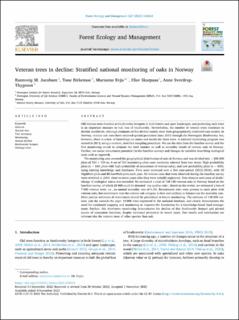| dc.description.abstract | Old veteran trees function as biodiversity hotspots in both forests and open landscapes, and protecting such trees is an important measure to halt loss of biodiversity. Nevertheless, the number of veteran trees continues to decline worldwide, although estimates of this decline mainly stem from geographically restricted case studies. In Norway, veteran oak trees have received special protection since 2011 through the Norwegian Biodiversity Act, however, there is a lack of knowledge on status and trends for these trees. A national monitoring program was started in 2012, using a random, stratified sampling procedure. We use the data from the baseline survey and the first monitoring revisit to estimate the total number as well as mortality trends of veteran oaks in Norway. Further, we assess recruitment potential (in the baseline survey) and changes in variables describing ecological state such as regrowth. The monitoring area covered the geographical distribution of oaks in Norway and was divided into > 200 000 plots of 500 × 500 m. A set of 500 monitoring plots were randomly selected from two strata: High probability plots (n = 100; plots with high probability of occurrence of veteran oaks), and Low probability plots (n = 400), using existing knowledge and databases. Plots were surveyed over a five year-period (2012–2016), with 20 HighProb-plots and 80 LowProb-plots each year. All veteran oaks that were observed during the baseline survey were revisited in 2019, three to seven years after they were initially registered. Tree absence and cause of death/ change of ecological status was recorded. We estimated a total of 138 100 veteran oaks in Norway based on the baseline survey, of which 25 000 could be denoted “top quality oaks”. Based on the revisit, we estimated a loss of 7 600 veteran trees, i.e., an annual mortality rate of 1.2%. Recruitment oaks were present in most plots with veteran oaks, but recruitment into the veteran oak category is slow and unlikely to balance out the mortality rate. More precise estimates of recruitment should be prioritized in future monitoring. The estimate of 138 000 veteran oaks far exceeds the appr. 10 000 trees registered in the national database, and clearly demonstrates the need for continued mapping and monitoring to improve the foundation for a knowledge-based land management. Further, this short-term monitoring demonstrates the decline of this biodiversity hotspot and pivotal source of ecosystem functions, despite increased protection in recent years. Our results and conclusions are relevant also for veteran trees of other species than oak. Quercus Ancient tree Tree inventory Monitoring Annual decline Biodiversity hotspot Heritage trees | |
